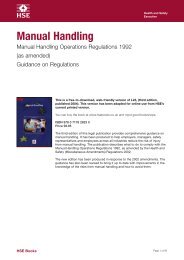Making Companies Safe - what works? (CCA ... - Unite the Union
Making Companies Safe - what works? (CCA ... - Unite the Union
Making Companies Safe - what works? (CCA ... - Unite the Union
You also want an ePaper? Increase the reach of your titles
YUMPU automatically turns print PDFs into web optimized ePapers that Google loves.
A related concern is <strong>the</strong> use of simple numerical indices like lost-time injury rates (LTIs) to<br />
measure performance. First, <strong>the</strong>se performance indicators tend to exacerbate <strong>the</strong> problem of<br />
management focus on <strong>the</strong> modification of workers’ behaviour ra<strong>the</strong>r than on eliminating or<br />
reducing hazards exposure. 46 Second, such indicators do not ‘count’ occupational health risks<br />
that are not associated with absenteeism, such as long-term health hazards. These health risks<br />
are a significant problem in <strong>the</strong> chemical, oil and o<strong>the</strong>r high-tech industries – which are<br />
precisely <strong>the</strong> industries most likely to purchase proprietary SMSs 47 – yet <strong>the</strong>y will not be<br />
reflected in <strong>the</strong> low injury and illness rates reported by firms like DuPont. Finally, as discussed<br />
above, <strong>the</strong>re are reports in <strong>the</strong> empirical literature that companies adopting <strong>the</strong> DuPont or<br />
similar systems discourage injury reporting through internal reward and punishment schemes,<br />
and manipulate statistics on injuries and ill-health by putting ill or injured workers on light<br />
duty (or no duty) so that <strong>the</strong>y do not appear in <strong>the</strong> lost-time injury statistics. 48 In o<strong>the</strong>r words,<br />
behavioural-based OHSM systems may actually lead to <strong>the</strong> suppression of evidence that<br />
would o<strong>the</strong>rwise trigger an inspection. 49<br />
Empirical studies concerning <strong>the</strong> impact of OHS management systems<br />
One notable finding following a review of <strong>the</strong> literature is that although <strong>the</strong> concept and<br />
supposed benefits of SOHSM and OHS management systems have become widely accepted<br />
by academics, policy makers and regulatory agencies, it is never<strong>the</strong>less <strong>the</strong> case that:<br />
“empirical studies have been few and critical evaluation of health and safety<br />
management systems… has been limited.” 50<br />
The evidence that does exist is distinctly mixed. Whilst some studies indicate that individual<br />
companies with SMSs have improved OHS performance, and that some industries within<br />
some countries have been successful in adopting a systems-based approach, <strong>the</strong> research has<br />
also identified problems of paper compliance, internal pressures not to report injuries and<br />
ill-health, and worker disempowerment. 51<br />
Gunningham and Johnstone, while acknowledging <strong>the</strong> “paucity of empirical evidence” 52 and<br />
<strong>the</strong> fact that findings are mixed, never<strong>the</strong>less maintain that <strong>the</strong>re is evidence that <strong>the</strong> best<br />
results in OHS are likely to be achieved by those who adopt a SMS 53 and point in particular<br />
to a report by <strong>the</strong> Industry Commission of Australia, research by Gallagher, and Norway’s<br />
experience with ‘Internal Control’. 54 Gallagher, for instance, found:<br />
“strong positive linkages between developed health and safety management<br />
systems and good health and safety performance, as measured by compensation<br />
claims incidence rates.” 55<br />
On <strong>the</strong> o<strong>the</strong>r hand, several studies have found no association between implementation of a<br />
systems-based approach to management and improved safety performance or improved<br />
corporate compliance. For instance, Nichols and Tucker report that:<br />
“a study of <strong>the</strong> International <strong>Safe</strong>ty Rating system used in South African mines<br />
found that more than eighty percent of gold and coal mines achieved <strong>the</strong><br />
highest ratings – four or five stars. Yet, <strong>the</strong>re was no correlation between star<br />
ratings and ei<strong>the</strong>r fatality or reportable injury rates.” 56<br />
Similarly, following a review of <strong>the</strong> empirical literature on <strong>the</strong> impact of internal compliance<br />
structures 57 in deterring corporate illegality Krawiec (2003) concluded that:<br />
“little evidence exists at all concerning <strong>the</strong> effectiveness of internal compliance<br />
structures as a means to reduce socially harmful conduct… [T]he evidence that<br />
does exist is decidedly mixed, with many of <strong>the</strong> most methodologically sound<br />
studies indicating <strong>the</strong> lack of effectiveness of such structures.” 58<br />
88<br />
Of particular note, a longitudinal comparison of <strong>the</strong> presence of internal compliance<br />
structures and <strong>the</strong> incidence of OHSA violations amongst 108 large US corporations found<br />
that internal compliance structures that closely mirrored <strong>the</strong> US Sentencing Guidelines’<br />
recommendations had no impact on corporate violation of OHS law. In fact, <strong>the</strong> study’s one<br />
robust finding was that:
















